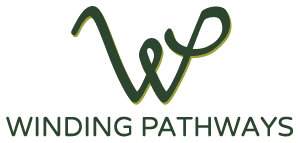by Winding Pathways | May 30, 2019 | (Sub)Urban Homesteading, Flowers/Grasses, Garden/Yard, Garden/Yard, Nature, Trees/Shrubs
Enjoying a Welcoming Yard
On the evening of May 17th, one of nature’s brightest colors greeted us at Winding Pathways. It was a brilliant male scarlet tanager, a somewhat rare bird that we only see briefly each May.
The next morning, he was joined by a female, and we assume they’ll nest in Faulkes Heritage Woods that adjoins our property. Tanagers are birds of the big woods, and they’ll find comfortable lodging in the big oaks nearby.
We bought Winding Pathways ten years ago partly because it adjoins the 110-acre Woods protected from development by a conservation easement. It’s mostly steep land that drops down to Indian Creek about a quarter of a mile from our home.
Creating a Welcoming Yard
Since we bought our land, we’ve diversified the yard by restoring prairies and increasing the variety of savanna and woodland wildflowers in shady areas, used prescribed fire to reduce exotics, and installed many birdhouses and feeders. Thanks to the nearby woods and our more open prairie yard with the savanna in between, we enjoy a rich array of bird species. Some, like woodpeckers and chickadees, stay around all year but more migrate to nest here or stop by on their trek to nest further north. We keep a running list of the birds we see from our dining room table each spring. Some we just see winging over but many stop to eat and rest.
-
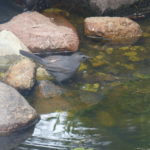
-
Catbird by water
-
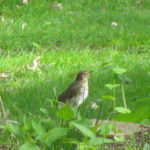
-
The Swainson’s Thrush moves through in the spring.
-
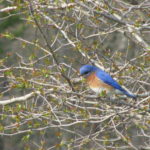
-
Bluebird in tree
Growing Bird List
We’re adding to this list daily but here’s what we’ve spotted and heard so far in May 2019:
Great Blue Heron, Barred and Horned Owl, Canada Goose, Black Capped Chickadee, Tufted Titmouse, Cardinal, White and Red Breasted Nuthatch, Downy, Hairy, Red Bellied, Red Headed, and Pileated Woodpeckers and Flicker, Turkey Vulture, House Sparrow, Wild Turkey, Red Breasted Grosbeak, Northern Oriole, Wood Duck, Common Yellowthroat, Indigo Bunting, Yellow Warbler, Louisiana Waterthrush, Blackpoll Warbler, Yellow Rumped Warbler, Scarlet Tanager, Eastern Kingbird, Phoebe, Great Crested Flycatcher, Cooper’s Hawk, Bald Eagle, Cowbird, House Sparrow, Starling, House and Carolina Wren, House Finch, Red Tail Hawk, Cooper’s Hawk, Crow, Pelican.
-
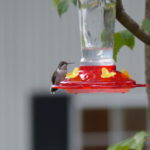
-
A hummer at the feeder.
-

-
A water source helps attract birds.
-
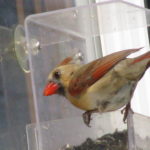
-
Female Cardinal at window feeder.
And the list keeps growing. You, too, can create a welcoming yard. This introductory YouTube video from Canada gives a quick overview of the important elements in attracting birds to a yard. It’s totally “Homegrown” and short. You can create welcoming space on a condominium patio, at a retirement or nursing home, an urban lot or spacious acreage.
Another YouTube video explains how to bring natural elements together to create natural areas. In this case, a “forest.” Again, from large scale to small we can all do this! We would, naturally, adapt to our region of the country and world. The concepts are similar.
What to Consider When Creating a Welcoming Yard
How much time/money do you want to invest?
Do you want to create a naturalistic landscape with native plants?
Do you want to harvest food from the space?
Are your neighbors tolerant of change?
What local codes affect what you want to do? (Ordinances or Covenants)
How prevalent are deer in the neighborhood?
How long do you plan to live in the home?
-
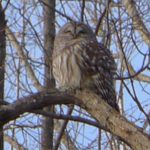
-
Waiting
-
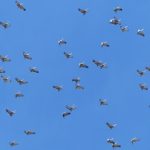
-
Wheeling overhead
-
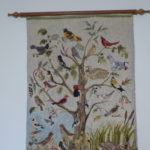
-
A hooked rug by Yvonne Fellows
We’re lucky to have Indian Creek and Faulkes Heritage Woods near Winding Pathways, but even yards not adjacent to natural areas can increase bird variety by creating diverse habitat. Spring is the best season to plant prairies and shrubs! Learn more about birds, their habits and habitats at the Cornell Laboratory of Ornithology.
-
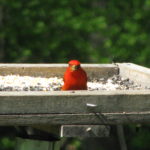
-
Extra nutrition at the feeder.
-
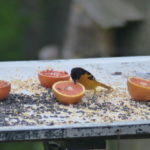
-
A male northern oriole
-
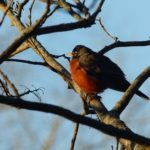
-
A robin surveys the area
by Winding Pathways | May 23, 2019 | Birds, Nature
A Tale of Baby Owls
Guest Blogger, R’becca Groff
The first sign of an owl living back on our acreage happened late last summer when I heard a rabbit being taken late one night. A rabbit sounds like a human baby when it’s in trouble, and it is the painful reality of the food chain.
Throughout this past winter, my neighbors and I have been listening to two owls living across our adjoining properties – a very large one and his smaller mate — we assumed.
I was the only one who wasn’t getting outdoors in time to see them, however.
The other day I heard the hooting midday and ran outside, determined to see where this owl was perched. It sounded so close to my office window. And there it was…staring down at me from one of the old Austrian pine trees between my house and my neighbor’s.
I spoke softly to it, hoping it wouldn’t mind but it wanted nothing to do with me, and promptly vacated its branch perch, gliding gracefully across my neighbor’s back yard to a safer distance.
As I’d been hearing about a huge hawk nest way at the back of our property line, I went to have a look for myself. Studying the tree line as I walked, I came upon an owlet watching down from one of the lower branches of another pine tree. I couldn’t resist it. I had to try and converse with this beautiful creature. It sat there watching back at me, unhinged by my presence. Just for fun, I circled the tree, and the baby followed my every move.
Of course, I texted the neighbors, only to learn there are two new owlets as my northern neighbors have been watching that hawk nest through binoculars. They’ve been observing as mama owl hunts and feeds these babies around dusk. She obviously is doing a fine job as we all have plenty of owl pellets on the ground around our trees.
Throughout the day I couldn’t keep away. I kept walking back out to view this new baby living in my yard. Later that day I finally caught a glimpse of its sibling perched near the top of the pine tree at the end of our acreage’s property line.
The neighbors and I had a chuckle, as we’ve noticed the rabbits seem to have moved across the street —
out of our yards!
-
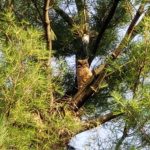
-
This owlet blends into the background of the pine bark trunk.
-
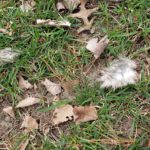
-
Look under trees for owl pellets.
-

-
Fuzzy owlet
by Marion Patterson | May 9, 2019 | (Sub)Urban Homesteading, Bugs, Foraging, Garden/Yard, Nature, Uncategorized
A delightful swatch of color flitted by as we sat on our back deck on one of spring’s first warm sunny days. It was a red admiral butterfly that landed on a post just a few feet from us. It appeared to be enjoying the weather as much as we were.
We’ve since spotted many red admirals in the yard, probably because stinging nettles thrive on the north end of our property. It’s the favored plant for red admiral caterpillars, although they’ll also live on other types of nettles. That poses somewhat of a dilemma.
What is a Red Admiral Butterfly?

These colorful butterflies depend on early blooming plants like nettles.
Red Admirals are a common butterfly across much of the temperate globe. They’re found across Europe and Asia, North Africa, Hawaii, and much of North America, especially the eastern half of our continent. The larvae feed on stinging nettles, which may not be native. So, if red admirals need stinging nettles what did they eat before the plant was introduced to North America in the early days of European exploration? It’s not even certain that stinging nettles are exotic. They may have been here all along, or early butterflies may have fed on wood nettles.
We appreciate both the insect and plant here at Winding Pathways. Red admirals add color and movement to the yard, while nettles make delicious eating. It’s the first wild green we harvest each early spring.
Can You Eat Nettles?
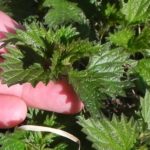
Carefully pluck the top three leaves off.
Stinging nettles are ready to harvest early – about the time when chard, spinach, and lettuce are planted. When the nettles are just a few inches tall we pluck off the top three or four leaves. They are called stinging nettles because the plant has tiny hairlike stingers. Walk through a patch in summer wearing shorts and nettles cause instant pain. But it’s temporary and not dangerous. Another name for the plant is the “seven-minute itch.” The sting comes from histamines.
We gather young nettles without getting stung by carefully plucking just the top leaves between our thumb and forefinger and snapping them off. About 100 young nettle tops make two servings. We bring them into the kitchen, rinse them a couple of times, and steam them for just a minute or two. The sting disappears and resulting greens are delicious. Plus they pack a nutritious array of vitamins and are high in protein.
Nettle season is short. By the time the plants are eight or ten inches tall, the new leaves are getting tough. But by then we’re harvesting chard and spinach from the garden.
We’re happy to share our yard with both red admirals and nettles. Anyone with a partly shady yard with damp soil might want to start a nettle patch. Wear a pair of gloves and dig up a few and plant them in the yard. They aren’t fussy and will provide excellent table fare and a higher likelihood that the yard will be home to the colorful butterfly.
by Marion Patterson | Apr 25, 2019 | (Sub)Urban Homesteading, Children/Play, Garden/Yard, Garden/Yard, Nature
-

-
Kids take to the woods.
-

-
Starting off carefully.
-
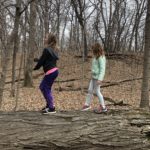
-
Walking confidently.
Kid Adventure
Nature reduces stress. We saw it in action at Winding Pathways on an early April Sunday morning.
About 15 kids from the Faith Formation Group of Peoples Church Unitarian Universalist visited. Most were five to ten years old. After collecting eggs and scattering treats for the hens, we took them to Faulke’s Heritage Woods. It’s a 110-acre woodland protected from development by a conservation easement held by the Iowa Natural Heritage Foundation.
It wasn’t a guided walk. It was a kid adventure. As we distantly watched, the kids scampered into the oaks where they discovered a huge fallen tree spanning a ravine. A natural bridge. They couldn’t resist making the crossing and then raced from fallen log to fallen log, traversing each. Laughter entertained the many standing trees as the kids were enveloped in nature, inventing games and having fun. No constructed playground in a city park or schoolyard matches the wonder and fun of ponds, prairies, and tiny streams.
-

-
Careful calculations
-
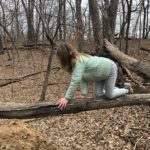
-
Learning to navigate a log.
-
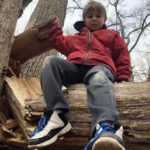
-
Exploring the log
Lots of research has been conducted on nature’s ability to relieve stress in both adults and children. Experts call time spent in beautiful places the nature pill and even 20 minutes spent walking in the woods reduces stress.
Everyone Benefits
Mary Carol Hunter recently completed a nature pill study and said, “Our study shows that for the greatest payoff, in terms of efficiently lowering levels of the stress hormone cortisol, you should spend 20 to 30 minutes sitting or walking in a place that provides you with a sense of nature.”
We’re lucky to have Faulke’s Woods adjacent to Winding Pathways, but most of our time outdoors is spent close to our home on our own property. Often, it’s simply sitting in the yard enjoying a cup of coffee as we watch chickadees flit around.
Hunter’s words, “sense of nature” are powerful. Although visits to national and state parks, wildlife refuges, and nature preserves are wonderful stress relievers, anyone’s yard or balcony can do the same. We created Winding Pathways several years ago to encourage people to enjoy their yard, even if that’s a tiny apartment balcony in a big city. Structuring the yard or balcony to create natural beauty attracts interesting wildlife while giving people easy and free access to the “nature pill.”
Go outside and have fun, just like the kids did in Faulke’s Woods.
by Winding Pathways | Apr 4, 2019 | Birds, Garden/Yard, Nature
As lingering snow banks melt we look forward to the arrival of our favorite spring guests. They arrive in late April, but we put out the welcoming mat a month ahead.

We welcome the wrens each spring
For many years a pair of house wrens have nested right outside our dining room window. We laugh at their bubbly energy and enjoy watching them bring caterpillar after caterpillar into their home to feed growing babies. In some years we get to watch as the youngsters peer outside their nest box before taking their first awkward and short flight.
How Many Species live in the United States?

Sometimes the Carolina wrens stay around in winter.
House wrens are only one of six wren species that live in the United States. We’re fortunate to have both house and Carolina wrens in our
yard. Carolinas don’t migrate, so we sometimes see one feeding on suet in winter. House wrens are, perhaps, wiser and leave Iowa each October to winter down along the Gulf Coast.
It’s almost magical when the house wrens return each late April. Suddenly the air is filled with their delightful song. We usually hear them before we spot their nervous energy as they seek a nesting location. The nest boxes we set up in March are their welcome mat.
Making a Birdhouse
Few birds are as easy to lure into a nest box as house wrens. In winter we make new ones out of scrap lumber. Wrens aren’t fussy. Many elaborate nest boxes can be purchased but all it takes to make one is a four-foot section of 1X6 inch pine lumber, a few nails, and simple tools. We like the plans posted on Birdwatching Bliss.
We’re crude carpenters but the birds don’t seem to mind if the joints aren’t perfect.
Many wren house plans call for a circular opening of 1 1/8th inch but we’ve had great success with a one-inch hole. Larger holes welcome messy house sparrows. We also never place a perch in front of the entry hole. Wrens are acrobatic flyers and have no trouble entering a hole without a perch nearby.
Entertainment
Few birds are as entertaining as bubbly house wrens, but there’s another reason we love having them around. They’re voracious predators of insects that love feasting on our garden crops, so our wren tenants help boost our vegetable crop.
Wrens start nesting almost as soon as they arrive. Their nest is carefully made of small sticks that nestle a few reddish spotted eggs that hatch in about two weeks. Babies grow like fury and leave the nest by the end of June. We then clean the nest out of the box, and often the eager parents produce a second brood in the late summer.
No bird is as likely to fascinate a child as a pair of bubbly wrens nesting in full view just outside the window.
-
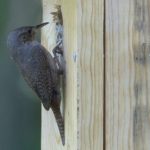
-
Checking the nest box.
-

-
Eggs are spotted reddish
-

-
Looking out at the world.
by Winding Pathways | Mar 28, 2019 | Birds, Nature
Too many people hate Canada geese. Once rare, this giant bird is now common across North America and enjoys living in town.
Geese were once uncommon rural birds, but starting several decades ago people began restoring populations in places where they were long absent. Our town of Cedar Rapids is an example. Nearly 40 years ago a few of the giant Canada subspecies were released in town. No one dreamed how successful they would be. Geese multiplied like crazy and now seem to be everywhere as they relax along the river or wing over downtown.
People dislike them because of the mess they leave on sidewalks, lawns, and golf courses. The expression loose as a goose is apt. Despite their mess, we find geese fascinating and love watching them, especially during our walks around Cedar Lake near downtown.

Geese pair up in late winter.
There’s much to admire about Canada geese. They mate for life and are devoted to their partner and babies, live many years, and have plenty of leisure to socialize and relax. Food is usually abundant. City geese enjoy eating lawn grass and the corn that spills from railroad cars.
Because geese are common, big, and unafraid of people they’re easy to observe. Having knowledge of their annual pattern can help see them as fascinating animals rather than messy pests.
The Seasonal Goose Pattern
FEBRUARY AND MARCH: Geese are now in pairs, rather than mixed in big flocks. Males and females show the same plumage, making it difficult to tell genders apart but usually, the ganders, or males, are slightly bigger than the females and have thicker necks. When we spot a lone goose in March, we know it’s likely a gander. Its mate is either laying an egg or incubating nearby but out of sight.
Goose nests are usually hidden, although sometimes one will be in plain view. Normally it will be in a low spot near water, but we spotted a goose nest in an old bald eagle nest high in a cottonwood tree. Over a couple of weeks, the female lays a clutch that can have from just a few to a dozen eggs. When the clutch is finished, she’ll start a 35-day incubation period. During this time, she stays out of sight. People are most likely to see a lone goose, the gander, in plain view nearby.
APRIL: Most goslings hatch in April, and the proud parents lead them to water. Amazingly these balls of fluff can walk and swim when only hours old. Mom and Dad protect them from predators and people who approach too closely. Crowd a goose family and the parents will hiss and threaten. A big goose is intimidating but we know it’s mostly bluff.
Often several goose couples bring their goslings together, so we sometimes see as many as 25 or 30 babies intermingled in big groups. Adults seem to share parenting duty.

Adult geese protect their young.
SUMMER: Goslings grow amazingly fast and by mid to late summer are almost as big as mom and dad. They gradually develop their adult feathers and by late summer look identical to their parents and have learned to fly.
FALL AND WINTER: When the grass stops growing our Cedar Rapids geese often leave town in the morning to fly into the country, where they snack on corn that farmers’ combines missed at harvest. They wing back in the evening and spend the night along the Cedar River or lake. Winter geese socialize in groups of 20 or 30. Should a hungry predator approach, the flock will make a racket and send it on its way.
Many Canada geese are migratory, although some stay in town all year. In the fall and winter, some individuals in a big group of geese may have hatched as far away as Canada, while others are locals. It’s during winter that young geese form pair bonds that can last for life. Usually the female determines where home is. So, if a Cedar Rapids hatched male goose takes a fancy to a young Canadian girl Canada goose, he will follow her north to nest, perhaps in Manitoba. But if a young Canadian boy goose pairs with a Cedar Rapids girl goose they’ll set up housekeeping here.
Geese are fascinating wild animals. Because they are amazingly common and easy to see they are one of the best birds to observe as they go about their annual pattern of life.
-

-
Crossing the trail
-

-
Geese flying
-

-
Adults and young on a lake.
